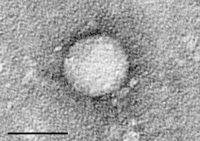
Photo from wikipedia
Although not directly cytopathic, hepatitis B and C viruses (HBV and HCV) are responsible for millions of deaths per year, and the aging patient population presents a severe public health… Click to show full abstract
Although not directly cytopathic, hepatitis B and C viruses (HBV and HCV) are responsible for millions of deaths per year, and the aging patient population presents a severe public health challenge. Most cases of acute HCV become chronic, but treatment has become increasingly successful following the development of direct acting antiviral agents. Conversely, most cases of acute HBV are cleared in the pre‐symptomatic stage and do not become chronic, but treatment options for chronic HBV are limited and rarely result in clearance. Despite these differences, interferon is partially effective against both viruses and has long been used in therapy. Newer treatments have largely moved away from interferon in favor of more targeted approaches, but interferon signaling remains the body's first line of defense against viruses. The recent discovery of type III interferon and IFNL4 has yielded new insights into the mechanism of ISG activation and revealed potential new therapeutic targets. J. Med. Virol. 89:388–396, 2017. © 2016 Wiley Periodicals, Inc.
Journal Title: Journal of Medical Virology
Year Published: 2017
Link to full text (if available)
Share on Social Media: Sign Up to like & get
recommendations!